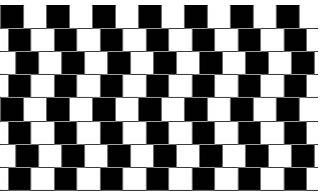Optical Illusions
|
Mentor: Our brains play an important part in how we perceive objects. For example, take a look at this tessellation and describe what you see:

Student: I see rows of crooked lines with a distorted checkerboard pattern in them. Mentor: Are you sure the lines are crooked? Student: Yes! They look wider at one end than the other. Mentor: Hold a ruler or other straight edge along the horizontal lines in the image and tell me what you observe. Student: (holding a ruler to the image) It doesn't seem possible, but the lines actually are straight! Why do they appear to be crooked? Mentor: It is an example of an optical illusion: something that appears to our eyes to have an effect that it does not really have. The placement of the alternating dark and light squares "tricks" our eyes into seeing the horizontal lines as crooked. Student: Oh, that reminds me of another similar "trick" my brother showed me. I will draw two lines, and you tell me which one is longer:
Student 2: The bottom line is longer. Mentor: It certainly looks that way, but this is another famous optical illusion. Both lines are the exact same length. The arrows lead our eyes to see the top one as shorter, because the lines draw our eyes together. The bottom one appears longer, because our eyes follow the outward arrows away. Student: You already knew that one! Mentor: Yes, there are many well known optical illusions we can learn about. After class you can do some research to find more! Did you know that color also affects the way we perceive tessellations? Student: Oh, that should be an interesting lesson, too! |

